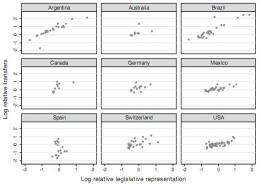May 11, 2011 report
Study shows overrepresented populations tend to receive disproportionate share of national funds

(PhysOrg.com) -- In a new study published in the Proceedings of the National Academy of Science (PNAS), authors Tiberiu Dragu and Jonathan Rodden show that many of the world’s democracies aren’t nearly as democratic as might be thought, at least when it comes to doling out cash from the central government. After careful statistical analysis, they show that less populated areas tend to get more money per capita than do those that are more heavily populated, resulting in inequities slanted towards more rural areas.
By studying nine democratic countries (federations) that collect money via taxes and then dole out that cash nationally, the authors were able to very clearly show that states or provinces that are sparsely populated almost always receive more money per person than do those with bigger populations. This comes about, they say, as a result of the way populations are represented in their national governments.
In the United States, for example, every state gets two senators, regardless of population. This means each state gets two votes on every issue that arises, which of course includes funding for projects and social programs. If two states, one sparse (Vermont for example has just over 600,000 people) and one heavily populated (say California, with a population of over 37 million), both receive grants of equal amounts to build a highway, say a hundred million dollars each; calculating the amount received per person in that state is as simple as dividing the total amount of money received by the number of people in the state, for that project, which would result, obviously, in a much higher number for the sparse state (166.7 million for Vermont, as opposed to 2.7 for California). This inequity, the authors point out, might not seem like such a big issue in already well established countries, but can be a serious sticking point in countries (such as Iraq, perhaps) that are still trying to move towards democracy. And of course, it’s not as cut and dried as all that because states with larger populations such as California, do receive far more funds overall, then do less populated ones; but as the authors note, the data shows that the sparser states, after all is said and done, do get a better deal.
Many previous studies have been done on this issue, leading to the same result; the difference with this study though, is that it focused on many countries, not just the United States, and used several decades of actual historical data to show that it’s not just the U.S. that has such inequities, but most modern developed democratic nations. The data, they say, also shows that it’s not the United States that has the biggest differential; it’s Brazil, where the sparsest states get up to five times the amount per capita, over those in the densest states, such as Sao Paulo.
The bottom line is, if federations wish to govern democratically, they should take a closer look at the data in studies such as this, before parceling out funds.
More information: Representation and redistribution in federations, Tiberiu Dragua and Jonathan Rodden, PNAS, Published online before print May 9, 2011, doi: 10.1073/pnas.1019061108
Abstract
Many of the world's most populous democracies are political unions composed of states or provinces that are unequally represented in the national legislature. Scattered empirical studies, most of them focusing on the United States, have discovered that overrepresented states appear to receive larger shares of the national budget. Although this relationship is typically attributed to bargaining advantages associated with greater legislative representation, an important threat to empirical identification stems from the fact that the representation scheme was chosen by the provinces. Thus, it is possible that representation and fiscal transfers are both determined by other characteristics of the provinces in a specific country. To obtain an improved estimate of the relationship between representation and redistribution, we collect and analyze provincial-level data from nine federations over several decades, taking advantage of the historical process through which federations formed and expanded. Controlling for a variety of country- and province-level factors and using a variety of estimation techniques, we show that overrepresented provinces in political unions around the world are rather dramatically favored in the distribution of resources.
© 2010 PhysOrg.com
















